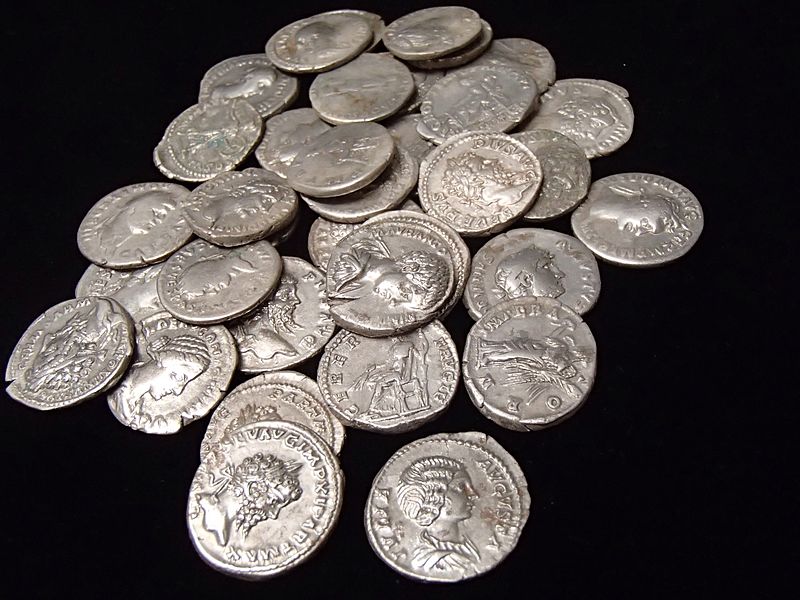Image: Some of the Overton coins after chemical cleaning for ID, December 2016 (FindID 806834)

Description: Treasure Case: 2016 T765 A hoard of 37 AR denarii and Nene Valley ware pot sherds. The Coins All are Roman silver coins of a denomination known as the denarius (plural denarii). The earliest was a coin of the Domitian while he was still junior emperor or Caesar under his father Vespasian (AD 69-79); the latest were minted during the reign of Septimius Severus (AD 193-211). The last closely datable coin is AD 205 (Severus TR P XIII; i.e. holding the annually renewable title of the power of tribune for the 13th time) although two coins of Severus's empress Julia Domna are only loosely datable up to the end of the reign. Summary <tbody></tbody> Reign of Vespasian (AD 69 - 79) - Domitian Caesar 1 Titus (AD 79 - 81) 1 Domitian (AD 81 - 96) 1 Trajan (AD 98 - 117) 3 Hadrian (AD 117-38) 4 Antoninus Pius (AD 138 - 161) 3 Diva Faustina I 4 Marcus Aurelius (AD 169 - 180) 1 Divus Antoninus 1 Lucilla 3 Commodus (AD 180 - 193) 3 Reign of Septimius Severus (AD 193-211):Wars of the Succession Septimius Severus (AD 193 - 211) 1 Clodius Albinus Caesar 1 Caracalla Caesar 1 Joint reign of Severus and Caracalla Septimius Severus 5 Julia Domna 2 Caracalla 2 Total 37 Date and Metal Content The coins satisfy the terms of the Treasure Act with regard to age and metal content. They are certainly more than 300 years old and all have precious metal contents far in excess of the 10% threshold. Of the same find? All the Roman coins listed here could plausibly have circulated together early in the third century AD (the first century coins are extremely worn) and it is unlikely that thirty seven such precious metal coins could have come from the same findspot area as a result of accidental individual deposition. Composition and the circumstances of discovery, including the remains of Romano-British pottery, would therefore suggest that these coins formed a hoard buried together in a ceramic jar for safekeeping in antiquity. Conclusion On the balance of probabilities, I conclude that this find constitutes a prima facie case of treasure under the terms of the Treasure Act (1996), by being a hoard of two or more precious metal coins of an antiquity greater than 300 years old and the pottery should be considered likewise by its association with the coins. Richard Abdy Curator, Roman coins Department of Coins and Medals British Museum 13.1.17
Title: Some of the Overton coins after chemical cleaning for ID, December 2016
Credit: https://finds.org.uk/database/ajax/download/id/593983 Catalog: https://finds.org.uk/database/images/image/id/593983/recordtype/artefacts Artefact: https://finds.org.uk/database/artefacts/record/id/806834
Author: The British Museum, Richard Abdy, 2016-12-09 16:18:22
Permission: Attribution License
Usage Terms: Creative Commons Attribution 2.0
License: CC BY 2.0
License Link: https://creativecommons.org/licenses/by/2.0
Attribution Required?: Yes
Image usage
The following page links to this image:

